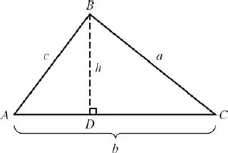8.4. Law of Cosines
To use the law of sines we need a known side opposite a known angle. Sometimes we do not have that information, as when, for example, we know three sides and no angle. We can still solve such a triangle using the law of cosines.
8.4.1. Derivation
Consider an oblique triangle ABC as shown in Fig. 8-27. As we did for the law of sines, we start by dividing the triangle into two right triangles by drawing an altitude h to side AC.
In right triangle ABD,
- c2 = h2 + (AD)2
But AD = b − CD. Substituting, we get
Now, in right triangle BCD, by the definition of the cosine,

or
Substituting a cos C for CD in Equation (1) yields
- c2 = h2 + (b − a cos C)2
Squaring, we have
Figure 8.27. Derivation of the law of cosines.

Let us leave this expression for the moment and write the Pythagorean theorem for the same triangle BCD.
- h2 = a2 − (CD)2
Again substituting a cos C for CD, we obtain
![]()
Substituting this expression for h2 back into (2), we get
- c1 = a2 − a2cos2C + b2 − 2ab cos ...
Get Technical Mathematics, Sixth Edition now with the O’Reilly learning platform.
O’Reilly members experience books, live events, courses curated by job role, and more from O’Reilly and nearly 200 top publishers.

